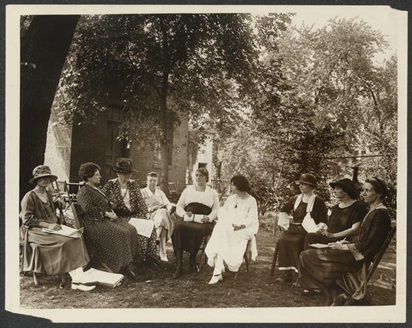Biographical Database of Militant Suffragists, 1913-1920
Biography of Edith M. Ainge, 1874-1948
__________________
By Jodi Oaks, Librarian, SUNY Oneonta
Edith M. Ainge was born in England in September 1874 to William and Susan Ainge. Her father worked as an accountant. Ainge immigrated with her family to North America in the early 1880s. It is possible they lived in Canada for some time before relocating to the U.S., as two of her brothers were born in Canada in 1883 and 1885. Ainge was the second oldest of nine children, including three younger sisters and four younger brothers. While in the U.S., Ainge completed all four years of high school. Ainge was an active suffragist, going so far as to state "suffragist" as her occupation on the 1920 U.S. Census.
Ainge served as national treasurer for the National Woman's Party and as a member of its National Council. In July 1918, Ainge attended the Republican State Convention in Saratoga, N.Y., at which she confronted Alice Hay Wadsworth, then president of the National Association Opposed to Woman Suffrage and the wife of Senator James W. Wadsworth. The actions of The Suffragists caused a "suffrage riot" to break out, during which a banner condemning Senator Wadsworth for not supporting women's suffrage was hung and promptly ripped down. In addition, Ainge travelled to Washington to picket with the National Woman's Party. She was a leader in the Watchfire demonstrations, being the first to light a fire in an urn in which suffragists burned speeches by President Wilson outside the White House on New Year's Day in 1919. Ainge was arrested for these actions. Overall, Ainge served five different jail sentences, including sixty days in Occoquan Workhouse in Virginia in September 1917, fifteen days in August 1918, and three shorter sentences in the District of Columbia city jail in January 1919 due to her actions in the Watchfire demonstrations. In February and March 1919, Ainge was part of a "Prison Special" tour, which travelled throughout the U.S. spreading the stories of women who had served prison sentences for picketing.
Even after ratification of the Nineteenth Amendment, Ainge continued fighting for equal rights for women. Through her work with the National Council of the National Woman's Party, Ainge helped write a proposal for an equal rights amendment to the U.S. Constitution. In 1923, Ainge accepted an invitation to be part of a delegation visiting President Calvin Coolidge to obtain action on the Equal Rights Amendment. Ainge never married. Living with her parents and siblings, she resided in Jamestown, N.Y. for most of her life. In 1933, she carried a picket banner reading, "Failure is Impossible" at the funeral of Alva Vanderbilt Belmont, who had been president of the National Woman's Party since 1917. In October 1948, Ainge died at her home in Western New York. She is buried in Lake View Cemetery in Jamestown, N.Y. Her gravestone reads, "Suffrage Leader."
Sources:
U.S. Census Bureau, 1900, "Edith M Ainge in household of William E Ainge, Jamestown city Ward 1, Chautauqua, New York, United States." U.S. Census Bureau, 1910, "Edith Ainge in household of William Ainge, Jamestown Ward 1, Chautauqua, New York, United States." U.S. Census Bureau, 1920, "Edith Mary Ainge in household of William Ainge, Jamestown Ward 1, Chautauqua, New York, United States." U.S. Census Bureau, 1930, "Edith Ainge, Jamestown, Chautauqua, New York, United States." U.S. Census Bureau, 1940, "Edith M Ainge in household of Clifford S Ainge, Angola, Evans Town, Erie, New York, United States." For details on Ainge's work with the National Woman's Party, see Inez Haynes Irwin, The Story of the Woman's Party (New York: Harcourt, Brace and Company, 1921), Chapters I, VI, VIII, XII, and XVI; "Women Involved in Suffrage Uproar at Saratoga Convention," The Journal and Republican, July 25, 1918, 2; "Woman's Party Meeting," New York Times, June 23, 1922, 9; "Miss Edith Ainge Treasurer of National Woman's Party," Plattsburgh Daily Press, August 2, 1922, 1. For mention of Ainge on the "Prison Special" tour, see "The Political Field," The Fulton Patriot, March 5, 1919, 1. For her work on the Equal Rights Amendment, see "Many States Will Send Delegates," Seneca County Courier-Journal, July 19, 1923, 1; "Women Open Fight for Equal Rights," New York Times, July 21, 1923, 8; "Plan Equal Rights Fight," New York Times, November 5, 1923, 15; "Coolidge Assures Women of Victory," New York Times, November 18, 1923, 22; "Adopt a Program for ‘Equal Rights,'" New York Times, December 8, 1929, 26. For details on her actions at the funeral of Alva Vanderbilt Belmont, see "Belmont Funeral to be Held Today," New York Times, February 12, 1933, 35; "Belmont Funeral a National Tribute," New York Times, February 13, 1933, 17. On her death, see "Miss Edith Ainge," New York Times, October 26, 1948, 31.

Images of Edith M. Ainge, 1874-1948: Formal portrait. Written on the back of the photograph: Miss Edith Ainge, Jamestown, New York. May 19, 1919. Library of Congress, Photographs from the Records of the NWP American Memory Website, http://nationalwomansparty.pastperfectonline.com/photo/25D47112-61F8-4512-BD9B-994389848329.

National Photo Co., Washington, D.C. Miss Edith Ainge, of Jamestown, New York, the first delegate to the convention of the National Woman's Party to arrive at Woman's Party headquarters in Washington, Miss Ainge is holding the New York state banner which will be carried by New York's delegation of 68 women at the convention meeting in Washington February 15th-18th. [Feb 1921] Image. Retrieved from the Library of Congress, http://hdl.loc.gov/loc.mss/mnwp.147004.

National Photo Co. National Council Meeting, 1924. L-R: 1. Dora Ogle Md, 2. Mrs. J.D. Wilkinson La, 3. Mrs. Lawrence Lewis Pa, 4. Lavinia Egan La, 5. Edith Ainge N.Y., 6. Alice Paul N.J., 7. Martha Souder Pa, 8. Florence Boeckel D.C., 9. Edith Hooker Nev. 1924. Image. Retrieved from the Library of Congress, http://hdl.loc.gov/loc.mss/mnwp.276048.
